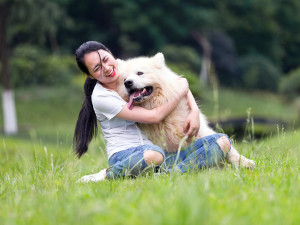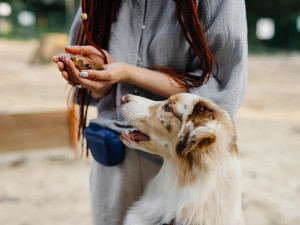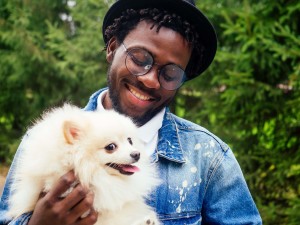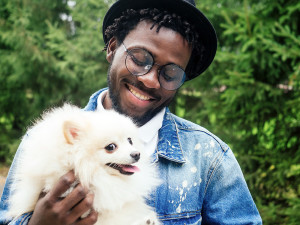Your Dog Can Read Your Mind, Kind Of
Researchers say dogs actually have a pretty good sense of what we’re thinking

share article
You can give up on hiding treats and spelling out ‘W-A-L-K’: as it turns out, your dog is a regular clairvoyant. OK, fine, it’s not that simple (and you don’t have to don a tinfoil hat just yet). But as Lucrezia Lonardo and Ludgiw Huber detailed in the 2023 scientific report, Canine perspective-takingopens in a new tab, scientists are working to prove something that a lot of pet parents have already guessed: our dogs know a lot about what we know.
Researchers are using all kinds of methods to understand whether our pups are able to walk a mile in our shoes. But as fun as these science experiments are to read about, they’re very relevant to pet parenting, too. As Shannon Kundey, one of the authors of Domesticated dogs (Canis familiaris) react to what others can and cannot hearopens in a new tab, says: “I think the important takeaway from studies exploring cognition in non-human animals is that there’s lots of interesting science going on to answer some of the questions that pet parents have wanted answers to. I would encourage pet parents to pay attention to the scientific literature, as science is likely to provide them with interesting insights into their pets.”
Below are some of the coolest things about dog mind-reading (OK fine, ‘perspective-taking’) that scientists have discovered – and the clever ways they went about their research.
Dogs know when we’re paying attention
Not a huge surprise, but still worth saying: pups can tell when we’re not focused on them – and they’re less likely to give us the time of day in return. In one studyopens in a new tab, dogs were asked to lie down for a duration of time. When the owner stayed facing the dog with their eyes on them, the dog would stay lying down. But when the owner looked away or seemed otherwise distracted, such as by reading a book or watching TV, the dogs were more likely to give up on following the cue. It’s sort of the puppy equivalent of passing notes in class when the teachers writing on the board.
In a similar studyopens in a new tab, dogs were given the chance to beg for food held by two humans: one who wasn’t facing the dog and making eye contact and one who was. The dogs preferred to beg to the human who was making eye contact, showing that they know when people are more likely to engage with their behaviour. So, hot tip for next snack-time: your pup might give up faster if you give them the cold shoulder.
Dogs know what we see
It might seem a little obvious to dog parents that dogs know when we’re paying attention to them – otherwise, they wouldn’t have gotten so darn good at doing adorably attention-grabbing things like, say, plopping their heads straight onto our keyboards when we’re busy working. So researchers went a step further and investigated whether dogs can understand what humans can see. This is called ‘Level 1 perspective-taking’ – and it turns out dogs are great at it.
To test this, researchersopens in a new tab placed a barrier between an experimenter and a bowl of food. As summarised by Lonardo and Huber, “dogs stole forbidden food more often when the orientation and location of a visual barrier prevented an experimenter from seeing them, compared to when the barrier was present but ineffective in blocking the experimenter’s view (due to its position and orientation).” In other words, they could tell when the barrier was actually working.
In one experiment, Deceptive-like behaviour in dogs (Canis familiaris)opens in a new tab, researchers gave dogs the choice between two forbidden treats: one behind an opaque barrier that the experimenter couldn’t see through and one behind a transparent barrier that both the dog and experimenter could see. The dogs first stole the treat behind the opaque barrier, showing that they’re able to consider what the experimenter can see. Interestingly, breed matters: independent working dogs (such as scent, sledge and sight hounds) were more likely to sneak around and first steal the treat behind the opaque barrier, while cooperative dogs (such as shepherds, retrievers and pointers) didn’t show a preference for stealing one treat first.
Dogs know what we hear
Shannon Kundey told us that she decided to research how dogs react to what humans hear because, “I think it’s important to explore how other species view the world generally. I think it helps us to learn about other species as well as ourselves as humans.” In her studyopens in a new tab, Kundey and other researchers provided dogs with a silent container and a noisy container, then forbid them from taking food from either. The researchers guessed that if the human who had forbidden them from taking the food was present but not looking at the dog or containers, the dogs would try to get the food from the silent container.
They were right; when their humans looked away, the dogs would sneak food from only the quiet container. This builds on the previous evidence that dogs know when people are paying attention, plus proves that they know that noise will alert us, even when we’re looking away. Like a teenager avoiding the creaky stair when sneaking out of the house, our dogs are well aware of what might perk up our ears.
Dogs know what we believe
Buckle in, because we’re getting a little more abstract. In this experimentopens in a new tab, one person (labeled ’the Knower‘) hides food or watches the food be hidden, and the other (‘the Guesser’) is out of the room when the food is hidden. In each case, the dog isn’t able to see the location of the food. The Knower then points to the correct container, and the Guesser points to an incorrect one. The dogs greatly preferred obeying the location pointed to by the Knower – in fact, they not only distrusted a human who was out of the room when the food was hidden, but they also disobeyed the cue of a human who “looked at the ceiling or covered their eyes with their hands during the food hiding process”.
In a similar experiment, the Guesser and Knower behaved identically, but one knelt on the side of a barrier that hid the hiding process. Dogs preferred to follow the Knower over the Guesser, meaning that – even when it wasn’t obvious – they were able to imagine what the Guesser and Knower could and couldn’t see.
Dogs know when we don’t know
In this experiment, dogs witnessed a human hiding food in bucket A and then moving it in their hands into bucket B. They could also see what the ‘communicator’ – the person giving the dog directions – could see from across the room. For half the dogs, the food was transferred in full view of the communicator, while for the other half, the communicator didn’t see the switch. All the dogs – regardless of whether their communicator had seen the switch or not – were then told to retrieve the food from bucket A.
The majority of dogs went straight to bucket B (duh – they know where the food is, and they want it now!), but of those who went to bucket A, more did so when the communicator hadn’t seen the switch. Dogs responded to “the communicator’s apparent knowledge” of where the food was; they followed along with incorrect directions given by ignorant instructors, but not with incorrect instructions given by instructors who knew better.
It’s possible that they followed the incorrect direction because they saw it as, as Lonardo and Huber put it, a “’justified’ mistake in ‘good faith’”. Interestingly, Terriers, who are considered independent breeds, were much less likely to follow the incorrect direction than Border Collies, who are considered a cooperative worker breed. This means, unsurprisingly, cooperative breeds might be a little more loyal – but also a little more willing to be led astray – than independent breeds.
So…are dogs really reading minds? What does it all mean?
Lonardo and Huber summarise: “dogs are exquisite readers of our behaviour” – and they might even have “a rudimentary theory of mind”, which is a set of skills used to understand the mental states of others when it comes to their beliefs, intentions and goals. A theory of mind helps creatures have empathy, but also helps them manipulate (unsurprising to anyone who has fallen victim to puppy-dog eyes). It’s long been understood to be a uniquely human cognitive feature, but all this new research is breaking that idea open.
Your pup doesn’t only know what you see and hear; they also know a bit about what you believe and how you think. So don’t bother trying to get anything past them, including the belly rub you have planned for later – they’re way ahead of you.

Sio Hornbuckle
Sio Hornbuckle is a writer living in New York City with their cat, Toni Collette.





